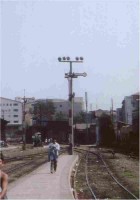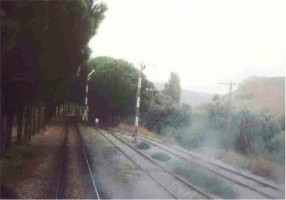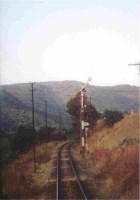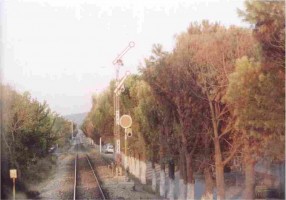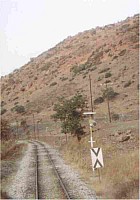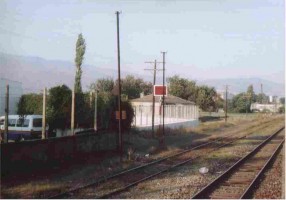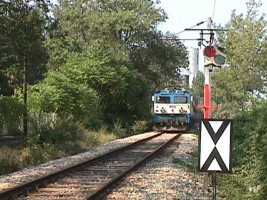TCDD Mechanical Signaling
Text and graphics prepared by Micheal Urlaub
TCDD mechanical signaling shows its “Germanic” origin: operational principles and products from the German Empire prevailed on Turkish State railways, instead of British or French techniques used on the different British and French companies operating private railway lines.
Semaphore main signals
Note: The appearance of TCDD semaphore arms can be different. The illustration shows the common appearances:
Semaphore Entrance Signals are placed 200 - 300 meters approach to the entrance point.
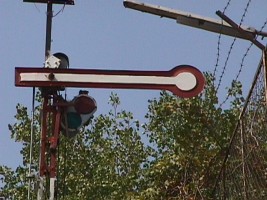
Semaphor at Hilal, August 2002; Photo Ergin Tönük | 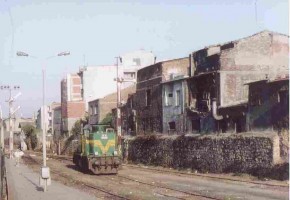
Open position, one semaphore arm raised 45 degrees above horizontal. Photo M. Urlaub |
   |
Closed position (entrance or exit signal): Two arms at stop position, Photo M. Urlaub |
 |
Open position, one semaphore arm raised 45 degrees above horizontal: For Entrance Signal Entrance permitted to the straight main running line or to a main line. For Exit Signal Exit permitted Exit signal, one arm raised: exit permitted. Photo M. Urlaub |
 |
Open position, one semaphore arm raised 45 degrees above horizontal: For Entrance Signal Entrance permitted to the straight main running line or to a main line. For Exit Signal Exit permitted from the straight main running line One arm clear |
 |
Open position, one semaphore arm raised 45 degrees above horizontal: For Entrance Signal Entrance permitted to the straight main running line or to a main line. |
 |
Open position, two semaphore arms raised 45 degrees above horizontal: If the signal has two semaphore arms: For Entrance Signal Entrance permitted over a route with points in diverging position. For Exit Signal Exit permitted over points in diverging position. Photo M. Urlaub |
 |
Open position, two semaphore arms raised 45 degrees above horizontal: If the signal has three semaphore arms: For Entrance Signal Entrance permitted to the main line, adjoining of the main running line. |
 |
Open position, three semaphore arms raised 45 degrees above horizontal: For Entrance Signal Entrance permitted nor to the straight main running line neither to the main line, adjoining of the main running line, but to another reception lines. |
Permissible Speeds over points:
Speed must not exceed 30 km/h over points in diverging position.
The authorized maximum speed over points in non-diverging position is:
- in stations, equipped with I-National type interlocking 55 km/h
- in stations with Taurus type interlocking 40 km/h
- in stations without any interlocking 30 km/h
These speeds apply unless otherwise instructed in working timetable.
Semaphore distant signals
Semaphore Distant Signals are placed 500 meters before the Semaphore Entrance Signal, and, eventually, direct at the Semaphore Entrance Signal.
Distant Signals of entrance signals are marked by a white board with two black V and are preceded by three announcing boards installed at 100 meter intervals.
Note: exit signals of stations secured by I-National type interlocking are pre-announced by a distant signal at the Semaphore Entrance Signal.
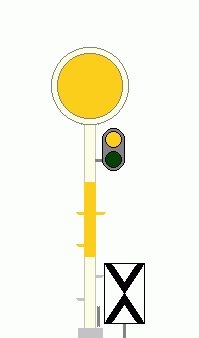 |
Closed position: The Semaphore Entrance Signal is at stop, or, if placed at the semaphore entrance signal, the Semaphore Exit Signal is at stop. |
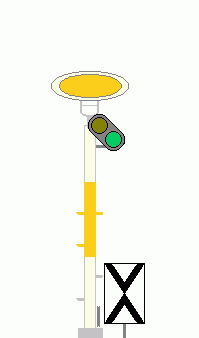 |
Open position (pivoted disk): The Semaphore Entrance Signal allows to proceed, or, if placed at the Semaphore Entrance Signal, the Semaphore Exit Signal allows to proceed. Photo M. Urlaub |
Mechanical Protection Signal
Stations where no Entrance Signals are installed, Mechanical Protection Signals can be provided. They are placed from the entrance points at a distance of 700 meters. Mechanical Protection Signals are marked by a white board with two black V and are preceded by three announcing boards installed at 100 meter intervals.
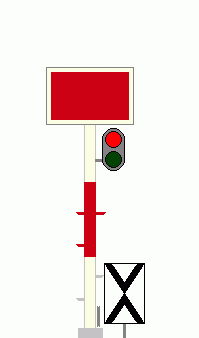 |
Closed position: passing prohibited. Photo M. Urlaub |
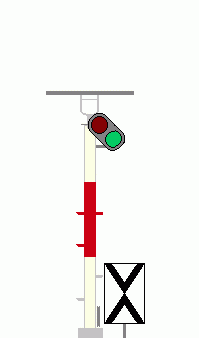 |
Open position: passing permitted as far as the entrance points and act in accordance with hand signals (flag signals) of the pointsman. Adapazari protection signal. 1 August 2002; Picture Ergin Tönük |
The flag signals of the pointsman are the following:
- A red flag (during darkness a red light) instructs the driver to stop immediately.
- A green flag (during darkness a green light) allows to proceed with caution. The local authorized speed applies over the following points or a speed of 25 km/h (or of 40 km/h for motor coaches) on the open line.
- The flag rolled together (during darkness a white light) allows normal speed.
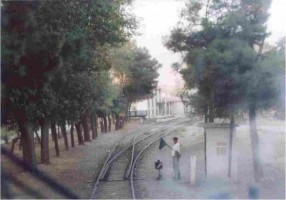
Pointsman showing green flag. Photo M. Urlaub |

